Written by Calvin on October 21, 2009/Calvin's Corner
Getting a Sense of the Problem
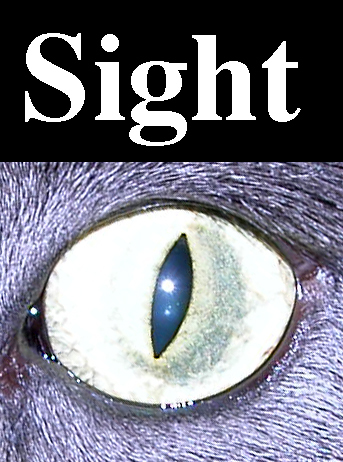
In bicycle repair, or any other mechanical work for that matter, we should bring to the table our five senses. We need as much input as possible in order to process the data and come to a resolution on the issues before us. This article will expatiate upon the “five senses” and how they facilitate our ability to diagnose and repair. There are some that may advocate for a sixth sense, but you will not find me among them.
Eyesight is the first of the senses that most people use and rely on, even to the point of taking it for granted. Eyes are complicated machines, if I am allowed that association. The eyes literally extend out of the brain. Besides being the “window to the soul,” the eyes gather images and feed these shadows and reflections to the brain for processing. We must keep in mind we only gather in reflections of light. The light that has struck the frame crack is reflected into our eye and is now focused by our eye’s lens on the retina, a curved sheet of light sensitive cells in direct communication with bundles of nerve cells. These cells’ chemistry is changed by the reflected light and sends data down the optic nerve, through the skull and directly to the back of the brain, to the patch of specialized brain tissue which receives visual data and sends messages to multiple regions of the brain in fractions of a second. Our brain then slowly responds to the data, “...is that really a crack?”
Seeing something is not as simple as “just looking at it.” Humans, like many mammals, are wired to see and respond to movement. Spinning a wheel to find a wobble in the rim creates movement that make changes in run-out show up easily. Articulating a brake or derailleur creates movement and allows us to see if it works normally. Does the movement occur on one or two planes? Is one piece moving eccentrically? This shows up in movements, such as rolling a bent axle over a flat surface rather then sighting along the side of an axle when it is stationary.
However, a mechanic must also make inspections when nothing is moving. After years of looking at technical things, we create in our “minds eye” a template or blue print of what it should look like. We use our experiences, our past impressions, as a reference when judging if something is odd. This is why experienced mechanics, those that pay attention anyway, are able to detect problems and find solutions faster and easier then a person starting with a blank slate.
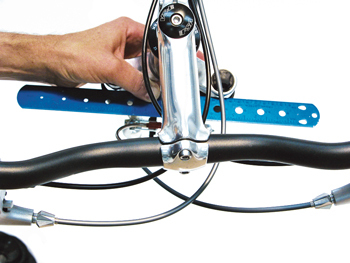 Use a ruler to help compare parallel lines
Use a ruler to help compare parallel lines
With vision, context is nearly everything. Optical illusions appear when the brain misinterprets the context of visual data. When possible, simplify your work area and backgrounds. Remove clutter. It can also help to extend straight lines from the edges of parts that should be parallel to help you see misalignments by enlarging the arc of the angle between the edges. For example, when sighting stems to wheels, especially short stems, it can be helpful to set a straight edge on the fork blades at the fork crown. This creates a reference line for comparison. Use the handlebars, not the stem, and align them parallel to the straight edge across the fork blades.
Again, our sense of vision is based on reflections, and that means light. We are primarily diurnal mammals, creatures of the sun. Even naturally low levels of crepuscular light lead to misleading impressions, and nocturnal wanderings are dangerous without the aid of artificial light, such as fire, a torch, or a head lamp. Hence, when working, get some light! For shops, use good light sources from different angles, and plenty of it. Paint flat surfaces white or off-white. For home mechanics, I have the same advice; get some light on the bike and your workspace. For race mechanics, sorry, hurry up and do what you can in daylight, then head for what lighted area you can.
The senses of feel and touch are, I feel, greatly underutilized by many mechanics. Feel and touch are tied to our sense of the hearing, as well, because many if not most noises on a bike resonate enough to feel. Hearing is simply sensing vibrations through the ear and ear channel.
When there is an audible click on a bike, such as from a headset or crank, place your fingers upon the offending item while stressing it in the directions that will reproduce the click. You can most always feel the resonance strongest in the piece that is part of the problem.
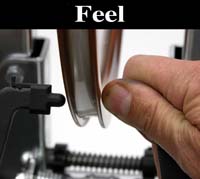
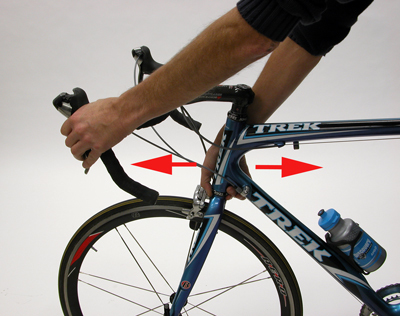
Lock the front brake and feel for movement at the fork/cup interface
Another useful use of touch and feel is to supplement, or in some cases, substitute for, sight. Very small anomalies and tolerances can sometimes be felt rather than seen. As an example, it is good to inspect each rivet on a used chain for proper rivet placement, burrs, twists, and other issues. In addition to looking, place a thumb and finger on the chain to feel any problems as the chain passes through.
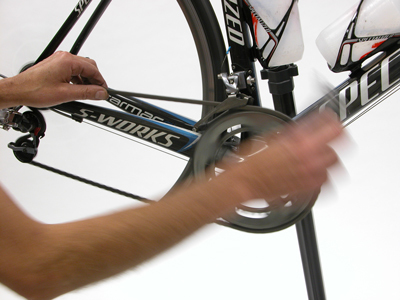
Spin the chain slowly as you look and feel for anomalies
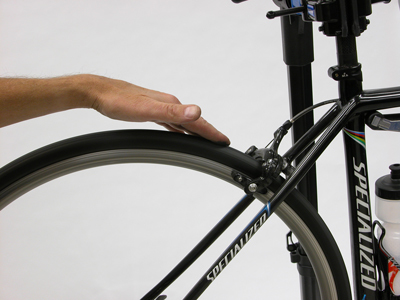
Spin the tire and feel for buldges and distortions in the tread
Our sense of touch is also another method to determine surface finish. Rim braking surfaces may be visibly acceptable but feel rough. Do not be shy about laying on hands and fingertips, but a word of caution is in order. There are abundant sharp edges, burrs, splinters and other cold-prickles on bicycles that await the inattentive mechanic, waiting to bestow the sting of pain and to draw blood.
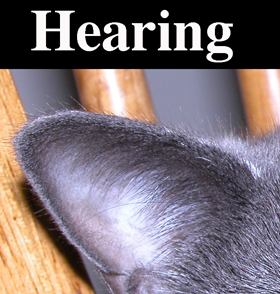
The bicycle generates a cacophony of sounds, and that is when things are working well. Tires rolling on the ground, the chain riding upon the sprockets, the clatter of a derailleur cage pushing the chain to the next gear, the howl of the brake as it controls your speed. These and many more will emanate from your vehicle.
Like many things, it is important to remember your school days, perhaps in the band. I will make an arbitrary division here into two types of noise, music if you will, that will concern us. The first type is “harmonic resonance.” This is the “slip and stick” of the bow passing over strings of the cello, the tone of the trombone, the brass tubing amplifying and coloring the vibration of the trombonist’s lips. These are examples of resonance.
The second noise type is the percussive noise, such as the sharp strike of the stick against the skin of the snare drum, and the hammer on the xylophone. On our bike, we may have the annoying “click-click-click” every pedal stroke. Another classic rattle is from a loose bearing, especially a loose headset. Pick up the front end, and drop it on a hard floor or the road, and listen for a tell-tale rattle that tapers off.
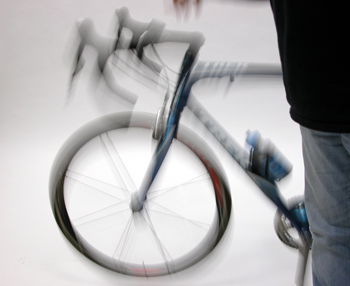 Drop the front and listen for a rattle, then isolate further
Drop the front and listen for a rattle, then isolate further
Even when things are working well, we have the clattering of the chain as the percussion section of our rolling orchestra. It is important to learn what the base level or “normal” noise is on your machine. Not only is there normal background bicycle noise, the timbre will vary from bike to bike. Carbon fiber tubing produces a different amplification than a steel frame, not unlike the difference between the warm tones of an Ovation® acoustic guitar contrasted to the amplified screaming of a Fender® electric guitar.
We are limited in the ability to hear. Humans are considered to have an ability to hear vibrations in the air between 20 hertz and 20,000 hertz. We cannot hear sounds that are lower then 20 hertz or higher than 20,000 hertz, though some animals can. Bats are capable of hearing higher frequencies, and whales and dogs can hear sounds below the 20 hertz range. Still, as a rule, assume that if we cannot hear something it is, most likely, not a problem. However, be aware of our limitations and changes. As we age, it is not uncommon to develop hearing loss, especially at higher frequencies. If a customer tells you there is a noise, do not assume they are hearing things!
The sense of hearing is based on vibrations, transmitted through bones in our ears. These are very small bits of hardware, known as the malleus, incus, and stapes (known here as the “pedal.” You may know the stapes as the “stirrup,” but equestrian nomenclature will not be used in this corner; at least not on my watch). An old mechanic’s trick is to use vibrations transmitted through solids directly to the inner ear. A screwdriver or similar tool is placed against the part suspected of creaking. The larger handle end is pressed against the skull next to the outer ear, while the noisy bicycle parts are worked or stressed.

Taste is so closely tied to smell I will address them both at once. Besides determining the direction of the coffee and donuts, taste and smell can be helpful in determining the contents of chemical blends, such as in lubricants and solvents. Compared to our canine friends, our nasal passages are not so finely tuned, nor our noses as long. However, the human nose is still quite sensitive.
Our sensation of taste and smell are said to reside in the brain and mind. The taste buds on the pores of the tongue respond to molecules of chemicals, giving us the so-called five taste sensations: salty, sour, sweet, bitter and umami. Our taste receptors are connected to sensory neurons that lead back to the brain. It is also said the memory of smells and taste are the most powerful. What experienced mechanic cannot recall shops and work of earlier times when exposed to WD-40, LPS-9, Tri-flow, Sturmey-Archer hub oil? Do not put these fluids in your mouth to taste them; however, with experience, the sense of smell can be useful to help determine the presence of certain chemicals in solvents or sprays.
Aromatic hydrocarbons such as toluene and xylene can be identified by their smell. An astringent smell may indicate the presence of caustic chemicals, which may damage the finish of aluminum. Strong alkaline solvents can etch the aluminum.
CONCLUSION
In this article, mechanics’ use of their senses of sight, hearing, feel, taste and smell were reviewed. There are situations where we may find something or seem to sense something, yet there is no clear explanation for the intuition. Rather then seeking a deeper solution, you may hear someone say that their “sixth sense” was the source of the impression. To my way of thinking, their sensory inputs were unconsciously processed, but they cannot remember the source of the sensation.
Simply put, stay awake and pay attention. Don’t try to “be one with the bike.” Be better than the bike. Use all of your senses.
Pay Attention!